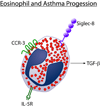Immunologic and inflammatory mechanisms that drive asthma progression to remodeling
- PMID: 18328887
- PMCID: PMC2386668
- DOI: 10.1016/j.jaci.2008.01.031
Immunologic and inflammatory mechanisms that drive asthma progression to remodeling
Abstract
Although histologic features of airway remodeling have been well characterized in asthma, the immunologic and inflammatory mechanisms that drive progression of asthma to remodeling are still incompletely understood. Conceptually, airway remodeling may be a result of persistent inflammation and/or aberrant tissue repair mechanisms. It is likely that several immune and inflammatory cell types and mediators are involved in mediating airway remodeling. In addition, different features of airway remodeling are likely mediated by different inflammatory pathways. Several important candidate mediators of remodeling have been identified, including TGF-beta and T(H)2 cytokines (including IL-5 and IL-13), as well as vascular endothelial growth factor, a disintegrin and metalloproteinase 33, and matrix metalloproteinase 9. Mouse models of airway remodeling have provided important insight into potential mechanisms by which TGF-beta activation of the Smad-2/3 signaling pathway may contribute to airway remodeling. Human studies have demonstrated that anti-IL-5 reduces levels of airway eosinophils expressing TGF-beta, as well as levels of airway remodeling as assessed by bronchial biopsies. Further such studies confirming these observations, as well as alternate studies targeting additional individual cell types, cytokines, and mediators, are needed in human subjects with asthma to determine the role of candidate mediators of inflammation on the development and progression of airway remodeling.
Figures



References
-
- Eder W, Ege MJ, von Mutius E. The asthma epidemic. N Engl J Med. 2006;355:2226–2235. - PubMed
-
- Cohn L, Elias JA, Chupp GL. Asthma: Mechanisms of Disease Persistence and Progression. Annu. Rev. Immunol. 2004;22:789–815. - PubMed
-
- Mauad T, Bel EH, Sterk PJ. Asthma therapy and airway remodeling. Journal of Allergy and Clinical Immunology. 2007;120:997–1009. - PubMed
-
- Boulet LP, Sterk PJ. Airway remodeling: the future. Eur Resp J. 2007;30:831–834. - PubMed
-
- Pascual RM, Peters SP. Airway remodeling contributes to the progressive loss of lung function in asthma: an overview. J Allergy Clin Immunol. 2005;116:477–486. - PubMed
Publication types
MeSH terms
Substances
Grants and funding
LinkOut - more resources
Full Text Sources
Other Literature Sources
Medical

